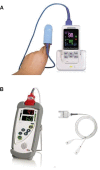Opportunities and barriers in paediatric pulse oximetry for pneumonia in low-resource clinical settings: a qualitative evaluation from Malawi and Bangladesh
- PMID: 29382679
- PMCID: PMC5829842
- DOI: 10.1136/bmjopen-2017-019177
Opportunities and barriers in paediatric pulse oximetry for pneumonia in low-resource clinical settings: a qualitative evaluation from Malawi and Bangladesh
Abstract
Objective: To gain an understanding of what challenges pulse oximetry for paediatric pneumonia management poses, how it has changed service provision and what would improve this device for use across paediatric clinical settings in low-income countries.
Design: Focus group discussions (FGDs), with purposive sampling and thematic analysis using a framework approach.
Setting: Community, front-line outpatient, and hospital outpatient and inpatient settings in Malawi and Bangladesh, which provide paediatric pneumonia care.
Participants: Healthcare providers (HCPs) from Malawi and Bangladesh who had received training in pulse oximetry and had been using oximeters in routine paediatric care, including community healthcare workers, non-physician clinicians or medical assistants, and hospital-based nurses and doctors.
Results: We conducted six FGDs, with 23 participants from Bangladesh and 26 from Malawi. We identified five emergent themes: trust, value, user-related experience, sustainability and design. HCPs discussed the confidence gained through the use of oximeters, resulting in improved trust from caregivers and valuing the device, although there were conflicts between the weight given to clinical judgement versus oximeter results. HCPs reported the ease of using oximeters, but identified movement and physically smaller children as measurement challenges. Challenges in sustainability related to battery durability and replacement parts, however many HCPs had used the same device longer than 4 years, demonstrating robustness within these settings. Desirable features included back-up power banks and integrated respiratory rate and thermometer capability.
Conclusions: Pulse oximetry was generally deemed valuable by HCPs for use as a spot-check device in a range of paediatric low-income clinical settings. Areas highlighted as challenges by HCPs, and therefore opportunities for redesign, included battery charging and durability, probe fit and sensitivity in paediatric populations.
Trial registration number: NCT02941237.
Keywords: Pulse oximeter; South Asia; children; oxygen saturation; pneumonia; sub-Saharan Africa.
© Article author(s) (or their employer(s) unless otherwise stated in the text of the article) 2018. All rights reserved. No commercial use is permitted unless otherwise expressly granted.
Conflict of interest statement
Competing interests: None declared.
Figures

Similar articles
-
Variability in the use of pulse oximeters with children in Kenyan hospitals: A mixed-methods analysis.PLoS Med. 2019 Dec 31;16(12):e1002987. doi: 10.1371/journal.pmed.1002987. eCollection 2019 Dec. PLoS Med. 2019. PMID: 31891572 Free PMC article.
-
The impact of pulse oximetry and Integrated Management of Childhood Illness (IMCI) training on antibiotic prescribing practices in rural Malawi: A mixed-methods study.PLoS One. 2020 Nov 19;15(11):e0242440. doi: 10.1371/journal.pone.0242440. eCollection 2020. PLoS One. 2020. PMID: 33211744 Free PMC article.
-
Usability Testing of a Reusable Pulse Oximeter Probe Developed for Health-Care Workers Caring for Children < 5 Years Old in Low-Resource Settings.Am J Trop Med Hyg. 2018 Oct;99(4):1096-1104. doi: 10.4269/ajtmh.18-0016. Am J Trop Med Hyg. 2018. PMID: 30141389 Free PMC article. Clinical Trial.
-
Pulse oximetry: why oxygen saturation is still not a part of standard pediatric guidelines in low-and-middle-income countries (LMICs).Pneumonia (Nathan). 2023 Feb 5;15(1):3. doi: 10.1186/s41479-023-00108-6. Pneumonia (Nathan). 2023. PMID: 36739442 Free PMC article. Review.
-
Pulse oximetry training landscape for healthcare workers in low- and middle-income countries: A scoping review.J Glob Health. 2023 Sep 22;13:04074. doi: 10.7189/jogh.13.04074. J Glob Health. 2023. PMID: 37736848 Free PMC article.
Cited by
-
Evaluation of the routine implementation of pulse oximeters into integrated management of childhood illness (IMCI) guidelines at primary health care level in West Africa: the AIRE mixed-methods research protocol.BMC Health Serv Res. 2022 Dec 24;22(1):1579. doi: 10.1186/s12913-022-08982-4. BMC Health Serv Res. 2022. PMID: 36566173 Free PMC article.
-
The impact of pulse oximetry on diagnosis, management and outcomes of acute febrile illness in low-income and middle-income countries: a systematic review.BMJ Glob Health. 2021 Nov;6(11):e007282. doi: 10.1136/bmjgh-2021-007282. BMJ Glob Health. 2021. PMID: 34824136 Free PMC article.
-
Usability of pulse oximeters used by community health and primary care workers as screening tools for severe illness in children under five in low resource settings: A cross-sectional study in Cambodia, Ethiopia, South Sudan, and Uganda.PLOS Glob Public Health. 2023 Jul 18;3(7):e0001800. doi: 10.1371/journal.pgph.0001800. eCollection 2023. PLOS Glob Public Health. 2023. PMID: 37463164 Free PMC article.
-
Experiences with use of a pulse oximeter multimodal device in outpatient management of children with Acute Respiratory Infection during Covid pandemic.J Family Med Prim Care. 2021 Feb;10(2):631-635. doi: 10.4103/jfmpc.jfmpc_1410_20. Epub 2021 Feb 27. J Family Med Prim Care. 2021. PMID: 34041052 Free PMC article.
-
Feasibility and acceptability of the paediatric pulse oximeter in integrated management of neonatal and childhood illnesses (IMNCI) services by public health facilities: A qualitative study in rural Western India.J Glob Health. 2023 Sep 15;13:04105. doi: 10.7189/jogh.13.04105. J Glob Health. 2023. PMID: 37712148 Free PMC article.
References
-
- World Health Organisation. Oxygen therapy for children: a manual for health workers. Geneva: WHO, 2016.
-
- Integrated Management of Childhood Illness (IMCI). WHO Recommendations on the Management of Diarrhoea and Pneumonia in HIV-Infected Infants and Children. Geneva: World Health Organization, 2010. - PubMed
Publication types
MeSH terms
Substances
Associated data
Grants and funding
LinkOut - more resources
Full Text Sources
Other Literature Sources
Medical
